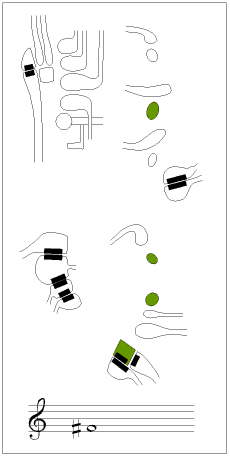Best Upper Register Bassoon Fingerings
As used by the CBSO bassoon section (in 1992!)
Click on a note to go to the fingering.


Left thumb helps to get and keep the right octave and intonation. It can be left off in fast passages if necessary.

Left thumb helps to get and keep the right octave and intonation. It can be left off in fast passages if necessary.

Left thumb helps to get and keep the right octave and intonation. The C# key (left little finger) may improve the sound. Either or both can be left off in fast passages if necessary.

Inclusion of right hand helps sound and intonation but can be left off in fast passages if necessary.

Make sure the crook key lock is off!
For difficult slurs to D you can touch the high-d key (left thumb top right) or use the same 3 fingers of the right hand as C#.
For difficult slurs to D you can touch the high-d key (left thumb top right) or use the same 3 fingers of the right hand as C#.

Leave off 1st finger of the right hand for slurs to this note. Eb key or C# key (left little finger) may improve the sound but can be left off in fast passages.

Leave off 1st finger of the right hand for slurs to this note. Eb key or C# key (left little finger) may improve the sound but can be left off in fast passages.

Eb key or C# key (left little finger) may improve the sound but can be left off in fast passages.

Best fingering for sound, intonation and slurs.
Eb key or C# key (left little finger) may improve the sound but can be left off in fast passages.
Eb key or C# key (left little finger) may improve the sound but can be left off in fast passages.

Eb key or C# key (left little finger) may improve the sound but can be left off in fast passages.

Easy fingering for quick passages. Eb key or C# key (left little finger) may improve the sound but can be left off in fast passages.

The crook key usually helps. Eb key or C# key (left little finger) may improve the sound but can be left off in fast passages. If it is unusually flat then make sure that the ring on the right hand has opened!
